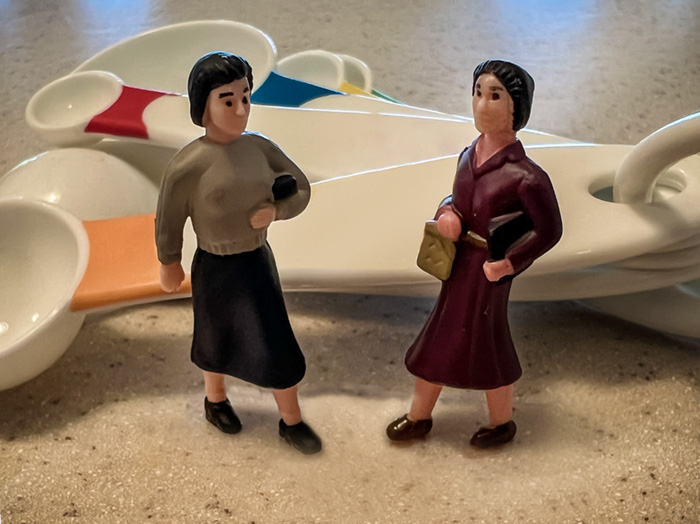We watch a little TV for a couple of hours at night and seem to stream the same old shows, time after time. I’m certain that just a few channels away, a more educational program exists. But I feel like I educate myself an awful lot during the day. At night, I want to be a little less brain-busy.
One show we like is CSI, mostly because of the characters. The forensics in the show is interesting too. Though, at times, they really gross us out with their very real special effects.
Their intro song, the theme is “Who Are You?” by The Who. And that is apropos, as that is the question in every criminal investigation. Just who are you, killer, robber, thief?
In one segment of the show, the killer was leaving dioramas for one of the investigators, showing the crime he had just committed. It was a real chiller.
But today, I happened upon a story about a woman named Frances Glessner Lee. I’d never heard of her before today, but it seems the field of forensic science owes much to Frances Glessner Lee. Because of her, “the who” has been discovered time and again. Using her invention of crime-scene dioramas.
First, a little about her life. Frances was born in 1878. Her father was John Jacob Glessner, — an industrialist working in the agricultural machinery business. As such, he amassed immense wealth, like in the way of $27 million by today’s money standard. So Frances grew up rich.
She received top-notch homeschooling. Along with that, she was very smart. People said she was an “intellectual force of nature” from a young age. This combined with her uncanny ability for crafting. As a young girl, she learned and loved the nuances of jewelry making, embroidery, knitting, and sewing. This would help her later in life.
But back to her young self. Frances wanted to work in medicine starting when she was a young girl. By the time she was in her teens, she had made up her mind that she would go to Harvard Medical School and become a doctor. What a world we live in, I’ll tell you. That door was closed to her, and so many others like her because Harvard Medical School wouldn’t allow women until 1995. Yes. You read it right. 1995.
Anyway, Frances decided it was Harvard or nothing. So instead, she married Blewett Harrison Lee, an attorney, and had three children.
A few decades later, in 1929, her children were grown, and she was divorced. She was 51 years old. It was then she turned her attention back to medicine. This time to “legal medicine,” which we now refer to as forensic medicine. This came after she’d had long discussions with her brother’s friend — George Burgess Magrath — about forensics. This fueled her curiosity.
Frances began endowing Harvard with her considerable wealth (1936). She wanted them to focus on the forensic sciences. As such, she gave the university $250,000 — that’s about $4.6 million today — to help build the Department of Legal Medicine.
In 1945, she developed a weeklong homicide seminar for police that focused on gathering forensic evidence.
But the thing that I’m getting to is Lee’s most notable contribution to the field of forensics. These were called her “Nutshell Studies of Unexplained Death.” They were a series of 19 dioramas of remarkable detail depicting various crime scenes.
We are talking intricate and precise detail about hangings, burnings, and death by gunshot. Anything. And these scenes were like miniature dollhouses with the roofs cut off. But the details were unimaginable. Like she put little individually wrapped lollipops at a newsstand. Or, there were accurate blood spatter trails on the wall next to a baby’s crib. Or tiny pillows with eensy buttons on couches where the dead person was lying, soaked in blood.
Lee used these dioramas in training lectures she gave police officers on crime scene forensics. Her “Nutshell Studies” remain in use to this day at the Maryland Medical Examiner’s Office in Baltimore.
They say that dioramas are so helpful in understanding a crime scene because they offer “a hands-on immersive experience” for students to learn from.
There is no substitute for being able to walk through a 3-dimensional space, and those dioramas offer this ability to investigators.
In creating these dioramas, Frances brought something to forensic science that no man before her had ever even dreamt of.
They were in about ten diorama episodes of CSI, too, I might add. The killer was sending them to Grissom anonymously. Taunting him. I never knew our good Frances was behind it all the time.
============
“It has long been an axiom of mine that the little things are infinitely the most important.”
― Sir Arthur Conan Doyle, The Memoirs of Sherlock Holmes
=============
“You need to let the little things that would ordinarily bore you suddenly thrill you.”
― Andy Warhol
============
“Life is just a lot of everyday adventures.”
― Carol Ryrie Brink, Caddie Woodlawn
=============
